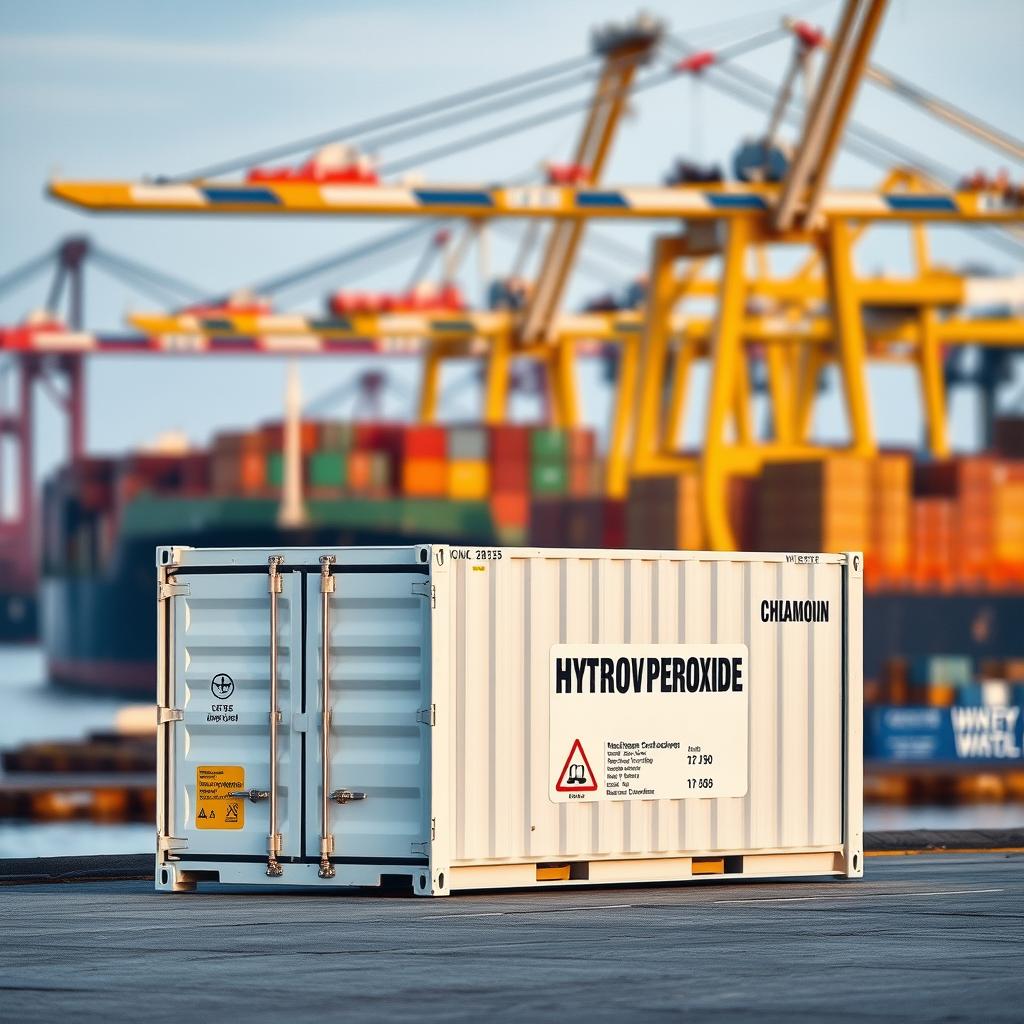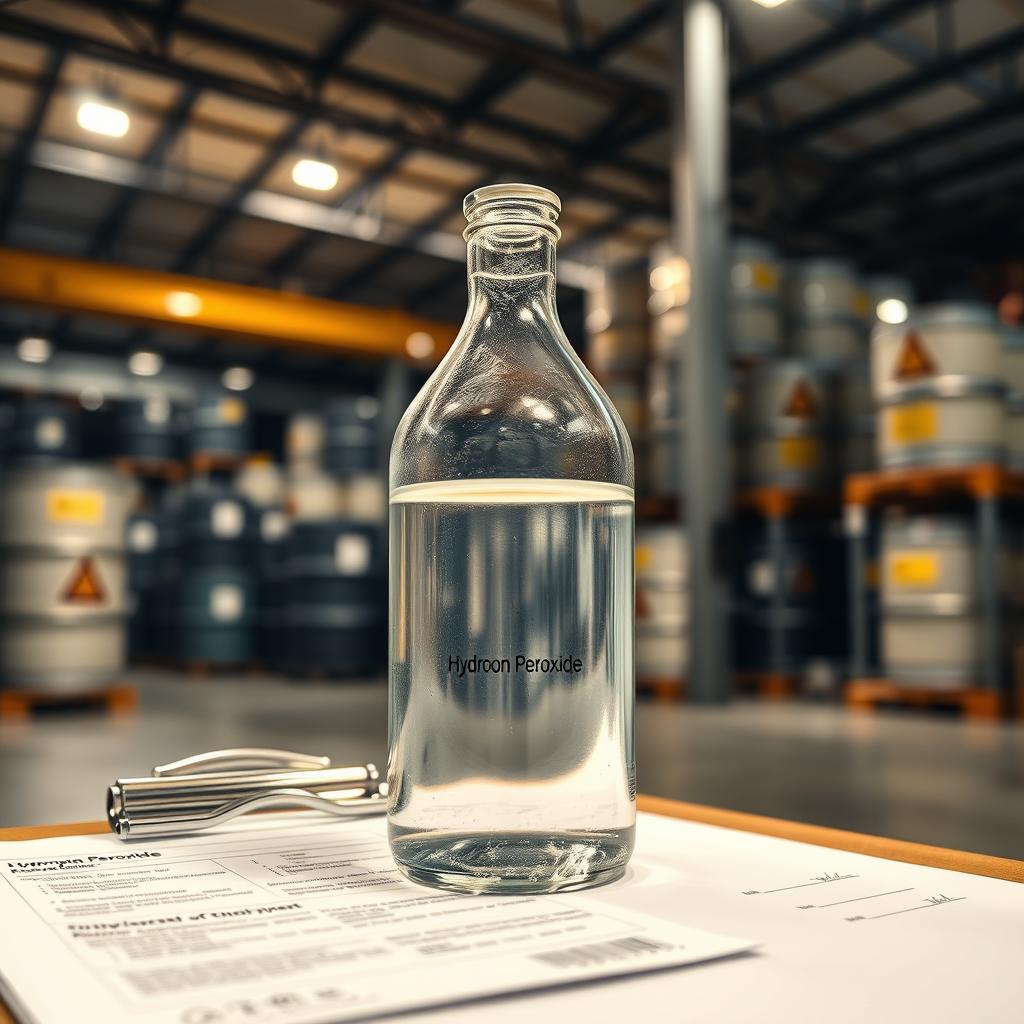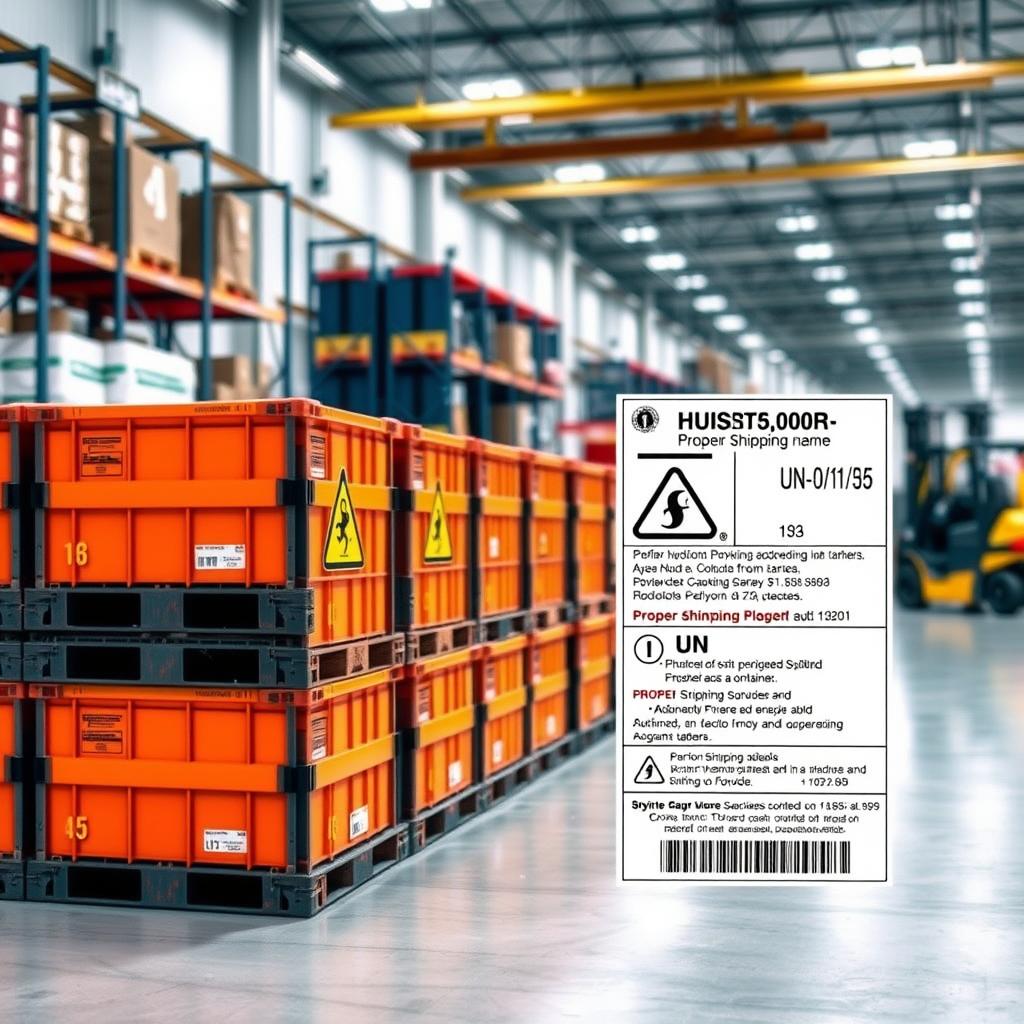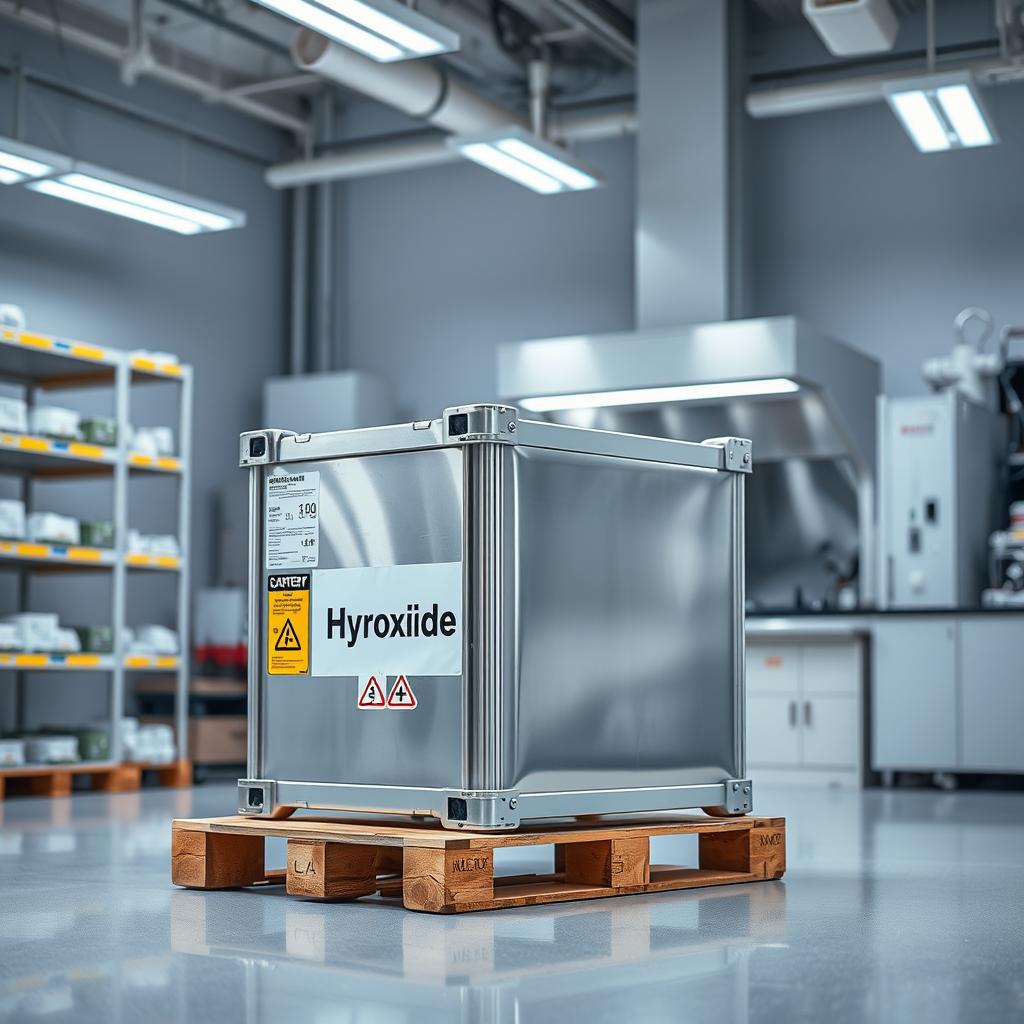Hydrogen peroxide shipping in the USA is complex. It’s all about the concentration levels and how they affect shipping. The rules are set by 49 CFR HMR, which guides how to ship hydrogen peroxide safely. Knowing these regulations is key to ensuring safe transport of this chemical. In the U.S., shipping hydrogen peroxide depends on its concentration. Each level has its own set of rules for handling, packaging, and moving it.
Key Takeaways:
- Hydrogen peroxide shipping regulations in the usa are based on concentration levels
- Different concentrations have different handling, packaging, and transportation requirements
- 49 CFR HMR dictates the rules for shipping hydrogen peroxide
- Hydrogen peroxide regulations are essential for safe and compliant transportation
- Understanding the regulations is crucial for companies involved in the shipping process
- Hydrogen peroxide shipping regulations in the usa are constantly evolving
Understanding Hydrogen Peroxide as a Shipped Material
Hydrogen peroxide is a chemical that needs careful handling and shipping. Its unique properties make it special. When shipping, it’s key to think about its reactivity and stability.
This info helps figure out how to store and transport hydrogen peroxide safely. It also ensures we follow the rules. When shipping hydrogen peroxide, some things to keep in mind include:
- Chemical properties and stability
- Commercial uses and applications
- General safety considerations, including the risk of decomposition and the release of oxygen
By knowing these factors and following the right guidelines, we can ship hydrogen peroxide safely and legally.
Chemical Properties and Stability
Hydrogen peroxide’s chemical properties are crucial for handling and shipping. Understanding these properties helps us take the right steps to avoid accidents. It also ensures we follow the rules.
Overview of US Regulatory Framework for Chemical Shipping
The US has strict rules for shipping chemicals. The Pipeline and Hazardous Materials Safety Administration (PHMSA) makes sure these rules are followed. They help keep everyone safe by guiding how to transport dangerous goods like hydrogen peroxide. These rules are in place to avoid accidents. They make sure hydrogen peroxide and other hazardous materials are moved safely.
Some important parts of these rules include:
- Following federal regulations, like 49 CFR §172.101
- Correct labeling and marking of dangerous goods
- Using approved containers and packaging
- Training and certifying people who handle hazardous materials
The PHMSA is key in making sure these rules are followed. They ensure the safe transport of hazardous materials, including hydrogen peroxide. By sticking to these regulations, we can all help prevent accidents and keep our communities safe.

Hydrogen Peroxide Shipping Regulations in the USA
Shipping hydrogen peroxide in the USA depends on its concentration. The federal government oversees these rules, but states may have their own. It’s key to know hydrogen peroxide regulations for safety and compliance.
The concentration of hydrogen peroxide affects its shipping rules. For example, solutions under 8% are not seen as dangerous and face few shipping limits. But, solutions between 8% and 20% are seen as UN2984, Class 5.1 (oxidizer), Packing Group III. This means they need more careful handling.
- Federal oversight and jurisdiction
- State-specific requirements
- International shipping considerations
Following hydrogen peroxide handling protocols is vital for safe transport and storage. This includes correct labeling, packaging, and paperwork.
Knowing and following hydrogen peroxide shipping rules helps avoid risks when moving this chemical. It’s important to keep up with new rules and guidelines for safe and legal shipping.
| Concentration Level | Classification | Regulations |
|---|---|---|
| Below 8% | Not hazardous | Minimal shipping restrictions |
| 8%–20% | UN2984, Class 5.1 (oxidizer), Packing Group III | Moderate regulations |

Classification Based on Concentration Levels
Shipping hydrogen peroxide in the USA has strict rules based on its concentration. Concentrations between 20% and 60% are UN2014, Class 5.1 (oxidizer) and Class 8 (corrosive). This means they need careful handling and transport. Knowing how to classify hydrogen peroxide is key for industries that move it. The concentration levels decide its class, which impacts shipping rules. For example, 20% to 60% is very corrosive. It needs special care in packaging and handling.
Here are important points for shipping hydrogen peroxide:
- Concentrations between 20% and 60% are classified as UN2014, Class 5.1 (oxidizer) and Class 8 (corrosive)
- Stricter handling and transport rules apply to these concentrations
- Special packaging and labeling are required for safe transport
Following hydrogen peroxide shipping rules in the USA is crucial. It ensures safe and legal transport of this substance. By knowing the classification based on concentration, industries can safely handle and transport hydrogen peroxide.

Packaging Requirements and Specifications
Proper packaging is key when moving hydrogen peroxide. It’s important to follow storage and handling rules to avoid accidents. The right container and venting are crucial for safety.
Transporters must keep hydrogen peroxide cool to prevent it from breaking down. This stops oxygen release and fire risks. By following the right steps, transporters can keep everyone safe.
Container Types and Materials
Containers for hydrogen peroxide need to be special. They must handle the chemical’s unique needs. Common materials include stainless steel, aluminum, and fiberglass-reinforced plastic.
- Stainless steel containers
- Aluminum containers
- Fiberglass-reinforced plastic containers
Venting Requirements
Venting is vital for hydrogen peroxide transport. Containers must let out oxygen and gases. This prevents pressure and accidents.
Temperature Control Measures
Keeping hydrogen peroxide cool is essential. High temperatures can cause it to break down. Transporters must use cool environments to keep it safe.
Labeling and Marking Guidelines
Proper labeling and marking of hydrogen peroxide shipments are key for safe transport. The hydrogen peroxide shipping guidelines require labels and markings to follow PHMSA rules. These rules help identify the chemical and its dangers.
Some important points for labeling and marking hydrogen peroxide shipments include:
- Using approved labels and markings that show the chemical’s identity and hazards
- Ensuring that labels and markings are clearly visible and legible
- Providing information on the chemical’s concentration and any relevant handling instructions
By following these hydrogen peroxide shipping guidelines, shippers can prevent accidents and meet regulatory needs. PHMSA regulations aim to protect people and the environment from hydrogen peroxide’s hazards.

Shippers should check the relevant regulations and guidelines for compliance. This might mean talking to regulatory experts or getting advice from industry associations. By focusing on compliance and safety, shippers can reduce risks and ensure a safe shipping process.
Documentation and Record-Keeping Requirements
Keeping accurate records is key to following us hydrogen peroxide transport rules and regulations. You need to keep up with records of shipments. This includes shipping papers, safety data sheets, and emergency response plans.
Shipping papers must have all the details of the shipment. This includes the type and amount of hydrogen peroxide, and any special handling or storage instructions. Safety data sheets are also crucial. They give important info about hydrogen peroxide’s chemical properties and dangers. These sheets must be given to those handling and transporting it.
Key Documentation Requirements
- Shipping papers with detailed shipment information
- Safety data sheets with chemical properties and hazard information
- Emergency response information, including spill response procedures and first aid measures
Keeping accurate records helps shippers and transporters follow the rules. It also helps prevent accidents and injuries. Remember, these records must be ready for regulatory authorities when asked. They also need to be kept for a certain time as the law requires.

Storage and Handling Protocols
Storing and handling hydrogen peroxide safely is key to avoid accidents. The hydrogen peroxide storage requirements say to keep it in vented containers. These should be away from organic materials, acids, and things that can catch fire. People handling and moving it need to know these rules well.
Some important things to remember for hydrogen peroxide storage requirements are:
- Keep containers in a place with good air flow.
- Don’t store it near heat or things that can start fires.
- Use the right materials for containers and tools.
- Make sure containers are labeled right with danger signs and how to handle it.
By sticking to these rules, we can lower the chance of accidents. It’s also important to remember that hydrogen peroxide storage requirements can change based on how strong it is and how it’s used. It’s also key to keep those who handle hydrogen peroxide up to date. They need to know how to store it safely and what to do in emergencies. This includes learning about spills, first aid, and how to act in an emergency.
| Storage Requirement | Description |
|---|---|
| Vented Containers | Storing hydrogen peroxide in vented containers to prevent pressure buildup |
| Compatible Materials | Using materials that are compatible with hydrogen peroxide to prevent contamination and reaction |
| Labeling and Signage | Labeling containers with correct hazard warnings and handling instructions |

Emergency Response Procedures
It’s vital to have emergency plans ready when working with hydrogen peroxide. These plans help reduce damage and ensure safety in emergencies. Knowing how to handle and ship hydrogen peroxide is key to preventing accidents and responding quickly. Good emergency plans include managing spills, giving first aid, and reporting incidents. People handling hydrogen peroxide need training. This training should cover how to handle and ship hydrogen peroxide safely.
Spill Management
Having a plan for spills is crucial. This plan might involve using absorbents, neutralizing the spill, and disposing of contaminated materials. Following hydrogen peroxide handling protocols helps prevent exposure and accidents.
First Aid Measures
Act fast if you’re exposed to hydrogen peroxide. Flush the area with water, remove contaminated clothes, and get medical help if needed. Always have a first aid kit ready and know how to use it.
Incident Reporting Requirements
After an accident, report it to the right authorities. This might mean filling out reports, telling regulatory agencies, and sharing details about the accident and response. Following hydrogen peroxide shipping rules in the USA is important for reporting. By following these steps and staying informed on hydrogen peroxide handling and shipping, you can reduce risks. This ensures a safe and effective response in emergencies.
| Emergency Response Procedure | Description |
|---|---|
| Spill Management | Contain and clean up spills using absorbent materials and neutralizing agents |
| First Aid Measures | Flush affected areas with water, remove contaminated clothing, and seek medical attention if necessary |
| Incident Reporting Requirements | Report incidents to relevant authorities, fill out incident reports, and provide information on cause and response measures |
Training Requirements for Personnel
Handling and transporting hydrogen peroxide needs special training. This ensures people follow hydrogen peroxide regulations and safety rules. The goal is to teach them how to handle dangers and act in emergencies.
Those who transport hydrogen peroxide must follow us hydrogen peroxide transport rules. These rules include getting certified and being checked regularly. This makes sure handlers and transporters know about hydrogen peroxide’s risks.
Certification Standards
Certification for hydrogen peroxide handlers covers many topics. They learn about the chemical, safe ways to handle it, and emergency steps. This training is key to avoiding accidents and keeping everyone safe during transport.
Periodic Assessment Requirements
Regular checks are needed to keep handlers up-to-date. These checks might include tests, practical skills shows, and site visits. They make sure everyone follows us hydrogen peroxide transport rules.
Training and certification help companies follow rules and reduce risks. This keeps workers, the public, and the environment safe.
| Training Requirement | Description |
|---|---|
| Certification Standards | Training on chemical properties, safe handling practices, and emergency response procedures |
| Periodic Assessment Requirements | Written exams, practical demonstrations, and on-site evaluations to verify compliance |
Common Compliance Issues and Solutions
Handling and transporting hydrogen peroxide requires knowing common compliance issues and solutions. This knowledge helps prevent accidents and ensures safe transport. Proper training and following hydrogen peroxide shipping guidelines are key.
Common issues include improper container venting and not controlling temperature well. To fix these, handlers and transporters can do a few things:
- Make sure containers are vented right to avoid decomposition and oxygen release.
- Keep hydrogen peroxide in temperature-controlled places to stop decomposition and keep it stable.
- Follow hydrogen peroxide storage requirements to avoid accidents and handle it safely.
By doing these steps and sticking to hydrogen peroxide shipping guidelines and hydrogen peroxide storage requirements, you can lower accident risks. This ensures hydrogen peroxide is transported safely.
Remember, regular inspections and maintenance of equipment and containers are also crucial. They help prevent issues and ensure hydrogen peroxide is handled and transported safely.
| Compliance Issue | Solution |
|---|---|
| Improper container venting | Ensure containers are properly vented |
| Inadequate temperature control | Use temperature-controlled environments |
| Non-adherence to storage requirements | Follow hydrogen peroxide storage requirements |
Conclusion
Understanding the rules for hydrogen peroxide shipping in the USA is key. It ensures this chemical is moved safely. By knowing the hydrogen peroxide regulations, handlers can follow the right steps. This includes classifying, packaging, labeling, documenting, and handling it correctly.
Following federal and state laws, as well as international rules, is vital. It helps avoid accidents and keeps everyone safe. Training programs, keeping accurate records, and watching out for compliance issues are also important.
By taking a detailed approach to hydrogen peroxide shipping regulations, we protect people and the environment. This also helps move this important chemical efficiently. With careful attention to safety, the industry can transport hydrogen peroxide safely across the USA.
FAQ: Hydrogen Peroxide Shipping Regulations in the USA
What are the key regulations for shipping hydrogen peroxide in the USA?
In the U.S., shipping hydrogen peroxide (H₂O₂) follows 49 CFR HMR. The Pipeline and Hazardous Materials Safety Administration (PHMSA) makes sure these rules are followed.
How is hydrogen peroxide classified for shipping based on its concentration?
Hydrogen peroxide’s shipping class depends on its concentration. Here’s how it’s classified: – Below 8%: Not hazardous, with few shipping rules. – 8%–20%: UN2984, Class 5.1 (oxidizer), Packing Group III—moderate rules. – 20%–60%: UN2014, Class 5.1 (oxidizer) & Class 8 (corrosive), Packing Group II—more strict rules.
What are the packaging requirements for shipping hydrogen peroxide?
Hydrogen peroxide needs to be in vented containers to avoid pressure. It also needs to be kept cool to prevent it from breaking down. This prevents oxygen release and fire risks.
What documentation and record-keeping are required for hydrogen peroxide shipments?
You need shipping papers, safety data sheets, and emergency response info. These must be kept up to date and available as needed. They help handlers and transporters know the dangers.
What are the training requirements for personnel handling and transporting hydrogen peroxide?
There are standards for training and regular checks. This ensures handlers and transporters know the dangers and can act quickly in emergencies.
What are some common compliance issues and solutions for shipping hydrogen peroxide?
To avoid problems, make sure containers are vented and transport is cool. This stops decomposition and oxygen release, common issues.

